Manufacturers: Find Our Open Jobs and Pathways to Careers at CreatorsWanted.org
Amid a workforce crisis, the National Association of Manufacturers and the Manufacturing Institute partner with FactoryFix to launch a new resource
Washington, D.C. – With the number of manufacturing job openings in the United States averaging 830,000 per month over the past year, the National Association of Manufacturers and the Manufacturing Institute have partnered with FactoryFix to launch and power Creators Connect, a new digital career resources platform designed to help students, parents, career influencers and job seekers easily explore and pursue the wide range of pathways available in modern manufacturing.
“Addressing the workforce crisis is among the top concerns for manufacturers across the country,” said NAM President and CEO and Manufacturing Institute Board Chair Jay Timmons. “While we cannot fully solve this challenge without immigration reform, manufacturers are determined to lift up more people in the United States with the promise and reward of modern manufacturing careers—and Creators Wanted’s new digital career resources platform is another way that manufacturers are leading with solutions.”
Creators Connect is the first and only unified platform to search and explore career pathways, job openings and job training programs across the entire manufacturing industry while making it easier for manufacturing professionals to attract and identify talent to fill the skills gap.
“We’ve made tremendous strides in inspiring a new generation of manufacturers at the Manufacturing Institute and across the industry, but what’s been missing is a single resource for manufacturing jobs and pathways opportunities,” said MI President Carolyn Lee. “Today, we bring an unmatched tool—in terms of volume and quality of jobs—to help us close the skills gap and change more misperceptions about modern manufacturing.”
Creators Connect is live on CreatorsWanted.org, home of the NAM and MI’s Creators Wanted campaign, which is the largest industry campaign to build the workforce of today and tomorrow. Since 2021, Creators Wanted has built an email network of more than 1 million students, early career entrants and potential career influencers. FactoryFix is already the leading manufacturing recruitment platform in the U.S., hosting more than 400,000 job openings and having its own talent network of more than 650,000 manufacturing workers. The partnership is the first of its kind for the industry’s largest and oldest manufacturing trade association.
“It’s an incredibly exciting opportunity for FactoryFix to be the engine behind Creators Connect and a part of the Creators Wanted campaign,” said FactoryFix CEO and Founder Patrick O’Rahilly. “As a one-stop recruiting solution for manufacturers to find qualified and engaged candidates, we’re looking forward to increasing our impact in addressing the labor shortage and helping more Americans create their future in modern manufacturing.”
By powering Creators Connect, FactoryFix representatives will join the NAM and the MI’s Creators Wanted workforce campaign as it continues its roadshow in 2023 and expands its digital campaign across the United States. By 2025, Creators Wanted aims to recruit 600,000 new manufacturing team members; increase the number of students enrolling in technical and vocational schools or reskilling programs by 25%; and increase the positive perception of the industry among parents and career influencers to 50% from 27%.
To explore Creators Connect, visit CreatorsWanted.org.
-NAM-
The National Association of Manufacturers is the largest manufacturing association in the United States, representing small and large manufacturers in every industrial sector and in all 50 states. Manufacturing employs more than 12.9 million men and women, contributes $2.81 trillion to the U.S. economy annually and accounts for 55% of private-sector research and development. The NAM is the powerful voice of the manufacturing community and the leading advocate for a policy agenda that helps manufacturers compete in the global economy and create jobs across the United States. For more information about the NAM or to follow us on Twitter and Facebook, please visit nam.org.
-Manufacturing Institute-
The MI grows and supports the manufacturing industry’s skilled workers for the advancement of modern manufacturing. The MI’s diverse initiatives support all workers in America, including women, veterans and students, through skills training programs, community building and the advancement of their career in manufacturing. As the workforce development and education partner of the NAM, the MI is a trusted adviser to manufacturers, equipping them with resources necessary to solve the industry’s toughest challenges. For more information on the MI, please visit https://www.themanufacturinginstitute.org.
-FactoryFix-
FactoryFix is the leading recruitment automation solution for manufacturing companies, combining the power of a talent network with specialized recruitment technology. Our platform helps HR manufacturing teams save time and budget by automating tedious tasks, streamlining recruitment efforts and providing a consistent flow of engaged candidates.
Founded in 2017 in Chicago, Illinois, FactoryFix has nearly 650,000 manufacturing professionals in its talent network and is the exclusive recruiting partner of the National Association of Manufacturers, Manufacturing Institute and Creators Wanted. Hundreds of the top manufacturing companies in the country trust FactoryFix to help meet their hiring goals. For more information, please visit https://www.factoryfix.com.
WATCH: 2023 State of Manufacturing Address
Presented by Jay Timmons, President and CEO of the National Association of Manufacturers, the 2023 State of Manufacturing Address was given from Husco International in Waukesha, Wisconsin. Special remarks were given by Kurt Bauer, President and CEO, Wisconsin Manufacturers & Commerce. Special thanks to Husco President and CEO Austin Ramirez and his team for hosting this year’s address.
Read the official remarks here.
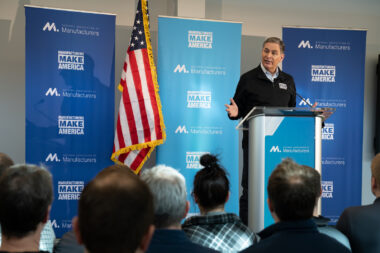
We’re hitting the road. This year’s NAM State of Manufacturing Address officially kicked off the 2023 leg of the NAM’s Competing to Win Tour. The tour will continue to spotlight the industry’s rapid transformation, while also focusing on manufacturing’s well-paying careers, diverse workforce and real-world solutions for the industry’s continued growth.
Upcoming stops: Waukesha and Pewaukee, Wisconsin (Tue, Feb 21); Fishers, Indiana (Wed, Feb 22); Harahan and Avery Island, Louisiana (Thurs, Feb 23)
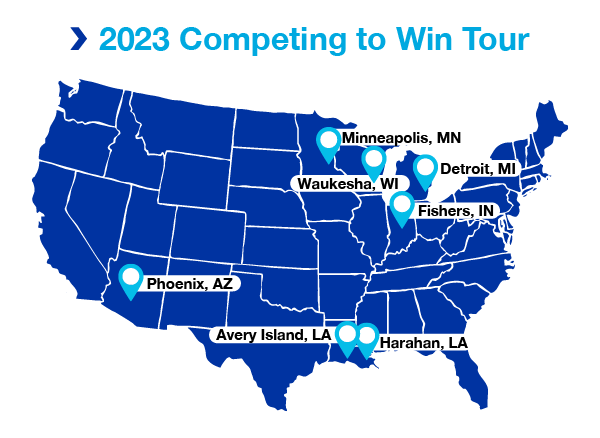
The Next Step in Building the Manufacturing Workforce
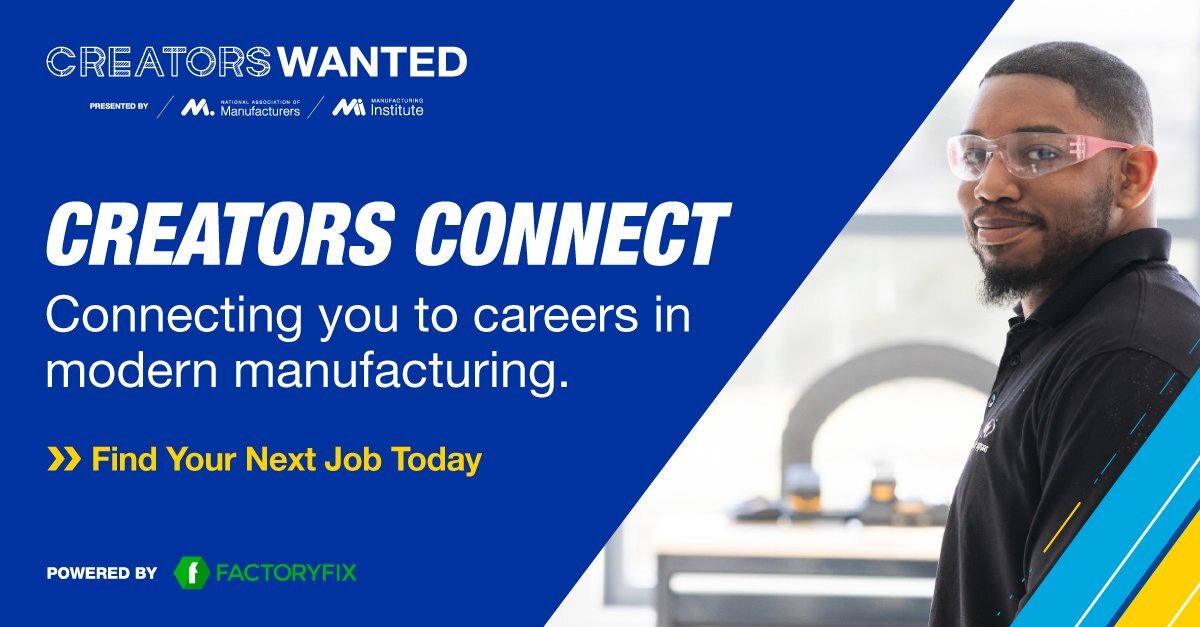
As part of the Creators Wanted campaign, the NAM and the Manufacturing Institute have partnered with FactoryFix, a leading one-stop solution for manufacturing recruitment, to launch Creators Connect.
- The digital career-resources platform aims to address the skills gap and misperceptions about the manufacturing industry, providing manufacturers with a powerful new tool to help build their workforces.
What it is: The platform, which is housed on Creatorswanted.org and powered by FactoryFix, is free to use. It is the first and only unified platform where users can search and explore job openings, career pathways and job training programs across the entire manufacturing sector.
- With more than 400,000 listed job openings, Creators Connect builds on the success of its parent initiative, Creators Wanted, the award-winning, national workforce and perception campaign of the NAM and its 501(c)3 workforce development and education partner, the MI.
- Creators Wanted, which has an email network of more than 1 million students, job seekers and career influencers, aims to recruit 600,000 new manufacturing workers by 2025.
- It is also working to boost the number of students enrolling in technical and vocational schools or reskilling programs by 25% and to increase the positive perception of the manufacturing industry among parents and career influencers.
Why it’s important: “Addressing the workforce crisis is among the top concerns for manufacturers across the country,” said NAM President and CEO and Manufacturing Institute Board Chair Jay Timmons.
- “While we cannot fully solve this challenge without immigration reform, manufacturers are determined to lift up more people in the United States with the promise and reward of modern manufacturing careers—and Creators Wanted’s new digital career resources platform is another way that manufacturers are leading with solutions.”
What’s next: The platform will benefit from FactoryFix’s talent network of more than 650,000 manufacturing workers—and the NAM and FactoryFix are confident it will help fill much-needed manufacturing jobs.
- Said FactoryFix CEO and Founder Patrick O’Rahilly: “As a one-stop recruiting solution for manufacturers to find qualified and engaged candidates, we’re looking forward to increasing our impact in addressing the labor shortage and helping more Americans create their future in modern manufacturing.”
Learn more about how to get the most out of Creators Connect by visiting the FAQ page here. Questions? Contact the Creators Wanted team here.
NAM Launches 2023 Competing to Win Tour
President and CEO Jay Timmons to Deliver the NAM State of Manufacturing Address
Washington, D.C. – The National Association of Manufacturers will kick off its 2023 Competing to Win Tour on Tuesday, Feb. 21, 2023, traveling to three states and visiting four manufacturing facilities along the way.
The tour will begin in Wisconsin, where NAM President and CEO Jay Timmons will deliver the 2023 NAM State of Manufacturing Address at Husco.
Throughout the week, Timmons will join local manufacturers, employees, media, community leaders and elected officials to discuss the challenging environment facing manufacturers and the urgent need for solutions on issues including immigration reform, permitting reform, workforce development, tax policy and more.
The tour comes as nearly two-thirds of manufacturers are concerned about the challenging economic environment characterized by inflation, supply chain disruption and the workforce crisis, according to the NAM’s latest Manufacturers’ Outlook Survey. More than three-quarters of respondents said pushing back against regulatory overreach should be the top priority of the 118th Congress.
“Our focus on this tour is telling the story of resilient, modern manufacturing—and the tools we need from policymakers to continue leading our economy forward and making the world a better place,” said Timmons. “To unleash our full potential, we need to reinstate critical tax provisions, a smarter, balanced approach to regulations, immigration reform and significant permitting reform, and reject top-down air regulations that cost jobs and snarl supply chains.”
For more than a decade, the annual NAM State of Manufacturing Address has focused the nation’s attention on the industry that is the backbone of the American economy, highlighting the 13 million men and women who are building our future.
The NAM has frequently traveled the country, bringing policy discussions and conversations about the future of work to shop floors, schools, economic clubs, televisions studios, the White House and more.
At a time when the future of work is top of mind for workers and thought leaders alike, the tour will also spotlight the industry’s rapid transformation, while also focusing on manufacturing’s well-paying careers, the industry’s diverse workforce and the real-world solutions for manufacturing’s continued growth.
Tour events will take place in Wisconsin, Indiana and Louisiana. Details are as follows:
Tuesday, Feb. 21 // Wisconsin
8:30 a.m. – 10:30 a.m. CST
Husco
2239 Pewaukee Road
Waukesha, Wisconsin 53188
11:00 a.m. – 12:00 p.m. CST
Waukesha County Technical College
800 Main Street
Pewaukee, Wisconsin 53072
Wednesday, Feb. 22 // Indiana
9:00 a.m. – 11:00 a.m. EST
INCOG BioPharma Services
12050 Exit 5 Parkway
Fishers, Indiana 46037
Timmons will be joined by Sen. Todd Young (R-IN)
Thursday, Feb. 23 // Louisiana
8:30 a.m. – 10:00 a.m. CST
Laitram
200 Laitram Lane
Harahan, Louisiana 70123
2:00 p.m. – 3:30 p.m. CST
McIlhenny Company
Highway 329
Avery Island, Louisiana 70513
MEDIA RSVP: Members of the media interested in covering the tour or attending an event should contact [email protected].
-NAM-
The National Association of Manufacturers is the largest manufacturing association in the United States, representing small and large manufacturers in every industrial sector and in all 50 states. Manufacturing employs nearly 13 million men and women, contributes $2.81 trillion to the U.S. economy annually and accounts for 55% of private-sector research and development. The NAM is the powerful voice of the manufacturing community and the leading advocate for a policy agenda that helps manufacturers compete in the global economy and create jobs across the United States. For more information about the NAM or to follow us on Twitter and Facebook, please visit www.nam.org.
Why Female Mentorship Matters in Manufacturing

A great mentor can make all the difference to your career—especially if you’re in an industry where you may find yourself in the minority. To help women in manufacturing reach their full potential in a male-dominated industry, the Manufacturing Institute’s Women MAKE America program has created a mentorship program, generously supported by its 35×30 Campaign supporters, Dow, General Motors, Arconic Foundation, Alcoa Foundation and Ketchie.
- The program has an ambitious goal: to train more than 1,000 female mentors by 2030 and connect them with younger women in the industry as well as students in colleges, high schools and middle schools.
One year into the program, the participants are already seeing an impact. In a recent Women MAKE webinar, attendees got to hear from one successful and happy mentee, while also receiving guidance on building their own slate of mentors.
Making a difference: “I was especially thankful for the Women MAKE Mentorship Program because it filled a gap in my support system and allowed me to have a mentor who was really dedicated to my professional development,” said Zen Saunders, a 2022 Women MAKE mentee and diversity, equity, inclusion and employee experience leader at Dow.
- Saunders explained that her mentor shared examples of how she built her career, which inspired Saunders to map out her own next steps more creatively. Through regular meetings with her mentor, Saunders learned to find common interests with colleagues and earn their buy-in on new projects.
- “[My mentor has] been an active listener and committed to my success, creating a safe space for me to learn from the challenges that I’ve faced while offering a refreshing perspective that’s uplifting and encouraging,” said Saunders.
Support from Women MAKE: After hearing from Saunders, participants in the webinar were asked to design a personal “board of directors” to mentor them in their own careers. Women MAKE hosts many such activities, which are designed to forge connections between participants and encourage them to think ambitiously about their career paths.
- The board members could be people from participants’ personal or professional lives, instructed MI Director of Women’s Engagement Sarah Shields. An ideal board of directors should include a sponsor, an innovator, an expert, a truth teller and a safe space.
- After they brainstormed a list of people who could fit these roles, Shields encouraged participants to ask these people to act as mentors and to schedule regular times to discuss their career plans.
The last word: “I’m thankful to the Manufacturing Institute for this opportunity and the amazing Women MAKE Mentorship Program. It’s really been a life-changing and transformative experience for me. I highly recommend this program for women and girls currently in or interested in the industry,” Saunders said.
Get involved: In addition to young and senior manufacturing professionals, this year Women MAKE is inviting young women and girls ages 13+ who are interested in STEM, as well as refugees seeking opportunities in the U.S., to join the Women MAKE Mentorship Program.
- If you are interested in joining the Women MAKE Mentorship Program as a mentor, or know of someone who would benefit from becoming a mentee, check out the application. The deadline for applying is Tuesday, Feb. 28.
- You can also tune in to the next Women Connect webinar on “Building Your Personal Brand” on Thursday, Feb. 16.
- And last, if you have questions, please contact the Women MAKE team at [email protected].
How Manufacturers Should Pursue Second Chance Hiring
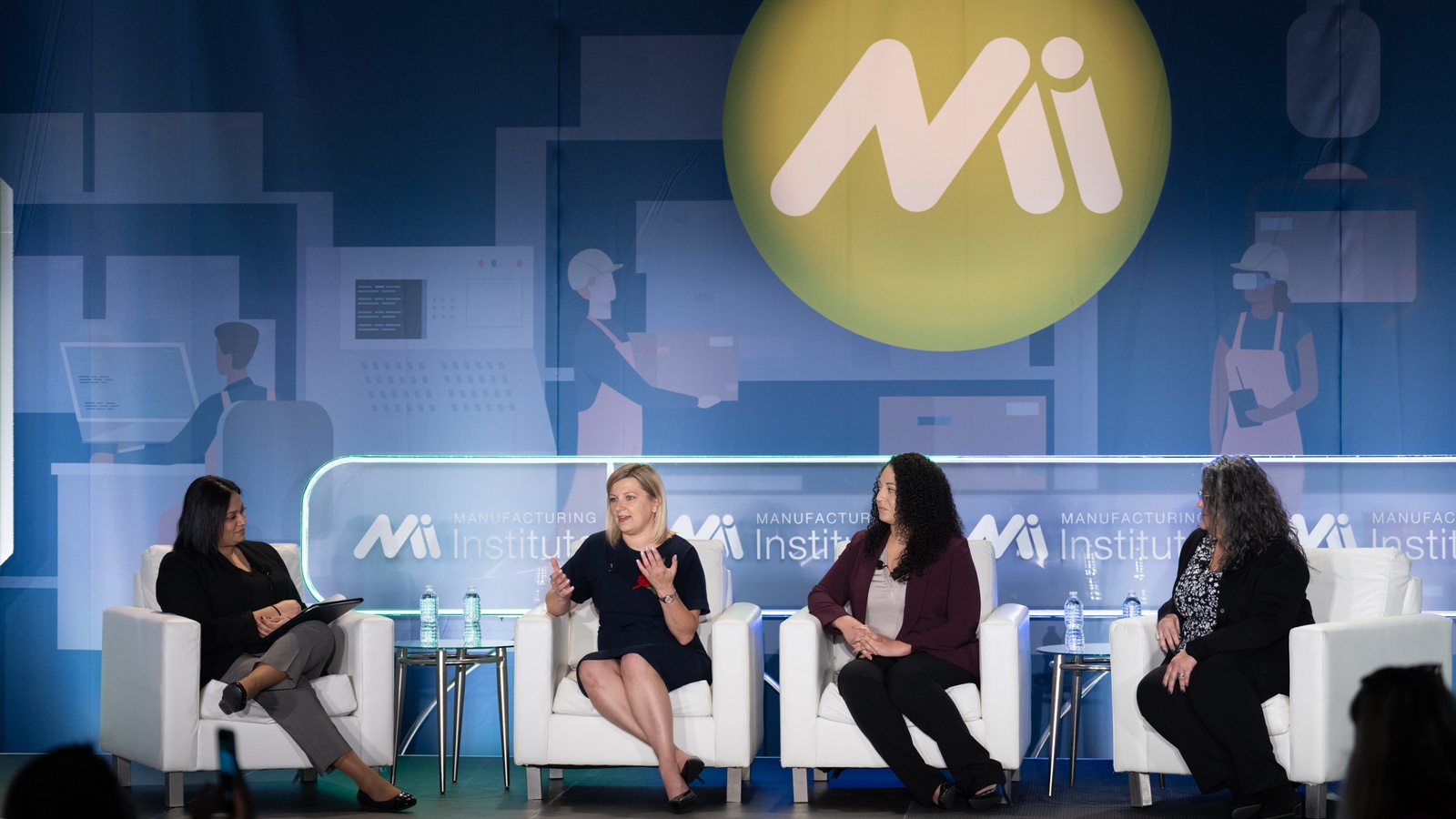
With one-in-four Americans possessing a criminal record, manufacturers who pursue “second chance hiring” are accessing a diverse and motivated talent pool. What do they need to know to begin?
At the Manufacturing Institute’s inaugural Workforce Summit, held in Cincinnati, Ohio, last October, panelists from manufacturers Saint-Gobain and JBM Packaging and from Envoy, a social impact advisory firm specializing in fair chance employment, shared tips on how to create such hiring programs.
Risk assessment: While safety is a concern, panelists emphasized that there is a difference between perceived risk and actual risk.
- “The data shows that second chance individuals are retained longer, have higher productivity and engage in more training than the average individual that you bring in,” said Cassi Zumbiel, managing director at Envoy.
- Saint-Gobain uses “a framework for background checks which we have developed in collaboration with our legal team. Candidates in the second chance hiring programs demonstrate higher level of commitment and a proactive approach to job searching, setting themselves up for success in future roles. We like to collaborate with our community partners in order to provide a good candidate experience and a seamless recruiting process,” explained Magda Dexter, senior vice president of communications and human resources at Saint-Gobain.
- For JBM Packaging, it’s about having honest and transparent conversations with candidates about their backgrounds. JBM also works with case managers to get referrals and assess candidates’ fit with the company.
How to get started: Dexter recommended that companies start with a pilot program, then scale it up, noting that it’s important to select a site that has the right culture, an engaged plant manager and HR support.
- Saint-Gobain has also tried out a variety of different support systems across their company, including hiring a part-time social worker as well as instituting a buddy system and a mentoring program.
- Zumbiel encouraged companies to do background checks only after a conditional offer has been made, recommending that companies should limit the look-back period to three to seven years. “That helps eliminate some of that bias and makes you really look at the candidate holistically.”
- Panelists also noted that it was important to review job descriptions to make sure they specify that second chance candidates are welcome.
From jobs to careers: Ninety percent of JBM’s second chance hires are entry-level production workers; the other 10% have mechanical or machinist skills and fill entry-level technical roles. However, Valerie Plis, director of human capital and culture at JBM, realized there was a lot of experience that the company wasn’t tapping into.
- Plis shared a story of a second chance hire who started as a machine operator. As Plis got to know her, she realized that the new hire had a background in training. The new hire progressed from an operator trainer to a lead trainer, then joined the HR team. In addition to leading training across the company, she now helms the second chance recruiting initiative, coming back full circle.
- Plis added, “At JBM, we started working on putting together some very defined career paths. It’s changed the way we conduct our performance reviews, so now we’re focused on growth and development.”
Succeed by partnering: While second chance hires come with a lot of benefits, there are also some challenges that are unique to this population. Partnering with community organizations can help, the panelists said.
- For Dexter, it’s about figuring out what the company will offer and what the community partners will offer. “We will support with on-the-job training. We will support with [providing] structure at work. We will rely on [our community partners] for job readiness and life skills training.”
- Zumbiel noted that “the community partner can advocate for the employer about the great opportunities and the benefits of working in manufacturing” and also prepare candidates to ace their interviews.
The last word: “A lot of the things we implemented, we thought we were doing just for our second chance population, but they actually ended up becoming a huge benefit for our entire workforce,” Plis said.
Watch: Timmons Talks Workforce on CBS
NAM President and CEO Jay Timmons joined CBS Mornings today to discuss manufacturing’s number one challenge: finding enough skilled workers to fill available jobs.
What Manufacturers Should Know about Hiring Military Talent
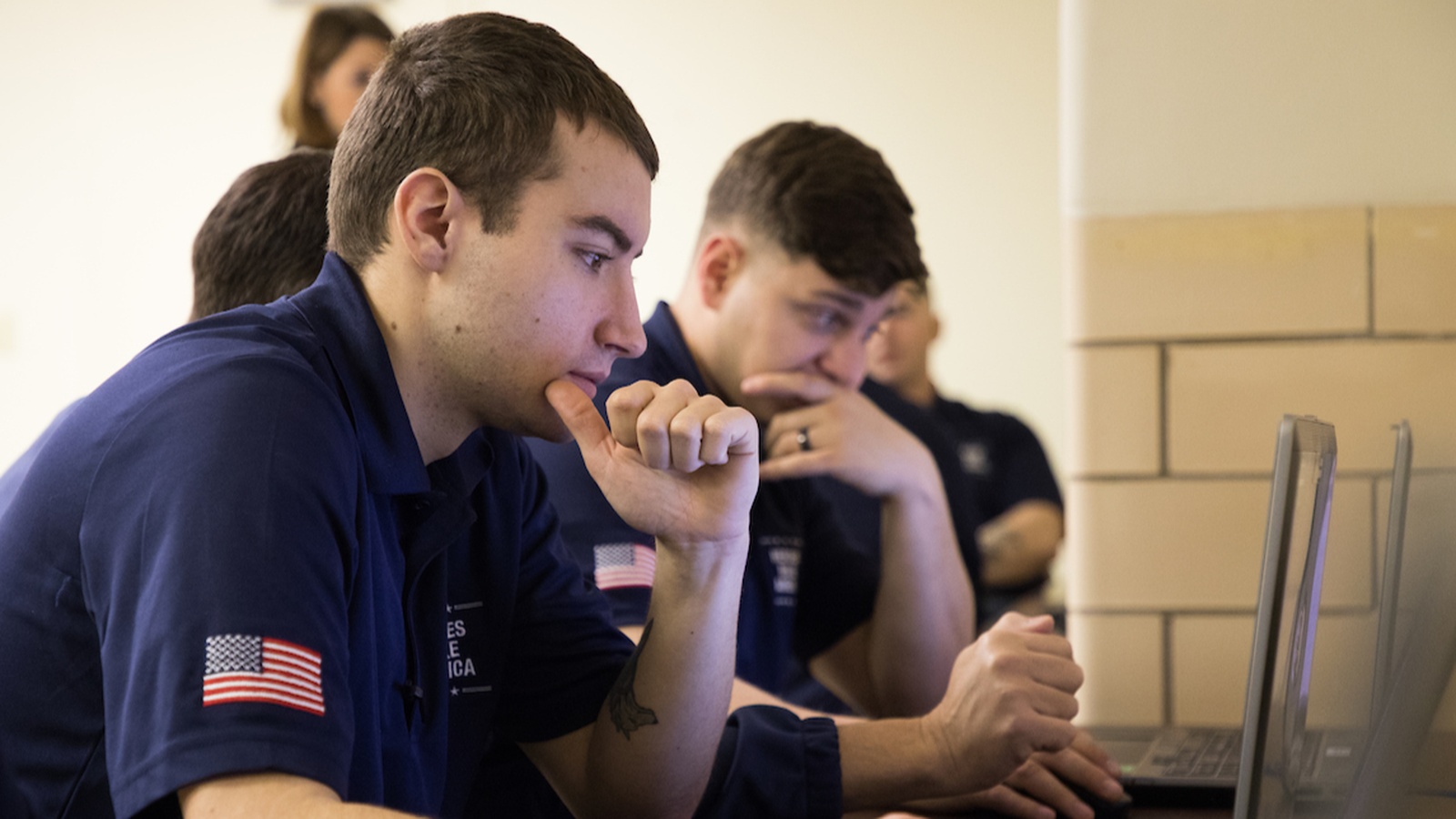
With 200,000 people transitioning out of the military annually, in addition to veterans, reservists and military spouses, the military population represents a highly skilled talent pool that manufacturers are eager to tap. But how should they go about doing so?
At a recent roundtable, the Manufacturing Institute—the NAM’s 501(c)3 workforce development and education partner—brought together veterans who have transitioned successfully out of the military into manufacturing careers, as well as manufacturers who have prioritized attracting and retaining military talent. The panelists discussed how companies can leverage this talent, and here’s some of what they had to say.
A great fit: “If you look at manufacturing, a large part of the job is doing things well, day after day after day—and that’s essentially what happens in the military. It’s that military discipline. It’s one of the most compelling reasons why we should be aggressively hiring military veterans,” said Dow Global Business Director Greg Bunker.
- “We’ve got three principles in our organization that we call ROI: responsibility, operational excellence and innovation. We know that veterans bring each of these to the table,” said UnitedHealth Group Director of People Analytics Troy Vandenberg (formerly director of people analytics at Smithfield Foods).
Networking matters: Transitioning from the military to the civilian workforce can be difficult, but veterans who make direct connections with manufacturers often land excellent job offers. The MI’s Heroes MAKE America program facilitates those connections, offering veterans opportunities to meet manufacturers as well as support in the job search process.
- Nicole Rena, an Army veteran and now a shift operations manager at Smithfield Foods, applied to five jobs at Smithfield and didn’t hear back on any of them. But then the program manager at HMA contacted Smithfield’s talent acquisition department to ask if they could speak with Rena about why she wasn’t chosen, so she could be more successful moving forward.
- As Rena put it, “The first 15 minutes of the call was about what I could do better on my resume, but after talking about my background and what I was looking for, the talent acquisition lead said he was going to count this as my first interview.”
- She landed the job! In her 18 months at Smithfield, Rena has been promoted twice.
Language can be a barrier: Rena’s experience speaks to one of the disconnects identified by veterans and manufacturers alike—the language used in job descriptions and resumes. Veterans often do not know how to best describe their skills and experiences in a way that civilian employers can understand.
- To avoid missing out on great talent, the panelists advised, manufacturers should ensure that a leader with a military background is involved in the hiring process, to translate military lingo and skills into more familiar manufacturing terms.
- Manufacturers should also specify in their job descriptions whether they will accept military experience as equivalent to an associate’s or bachelor’s degree, Bunker advised.
Support is crucial: Once veterans have been hired, the company must ensure they are set up for success. “Transitioning is a really scary process for veterans. It’s very stressful. The support that a company can provide is huge,” said Meg Zehringer, a Coast Guard veteran and a corporate environmental engineer at National Gypsum.
- Employee resource groups are a great way to provide support to veterans while also serving as a platform to advocate for population-specific needs, the panelists agreed.
- To be most effective, ERGs should be run by employees, not human resources departments, noted Vandenberg. Bunker added that establishing connections between the ERG and company leaders is also key.
The last word: “Equally as important as the wording of your job descriptions and preferred skills is creating a culture that invites a diverse group of people. That’s going to play a huge factor in attracting veterans,” said Zehringer.
Get involved: If you are interested in learning more about HMA, its next Heroes Connect event will be a networking opportunity with Johnson & Johnson on Wednesday, Jan. 25.
- You can also tune in to (or share with interested veterans) this Veterans Learning Series workshop on how to use LinkedIn effectively, coming up on Thursday, Jan. 26.
- And last, HMA will be hosting a virtual hiring fair in late February. Keep an eye on the MI website for updates!
What Foundations and Corporate Donors Are Looking For
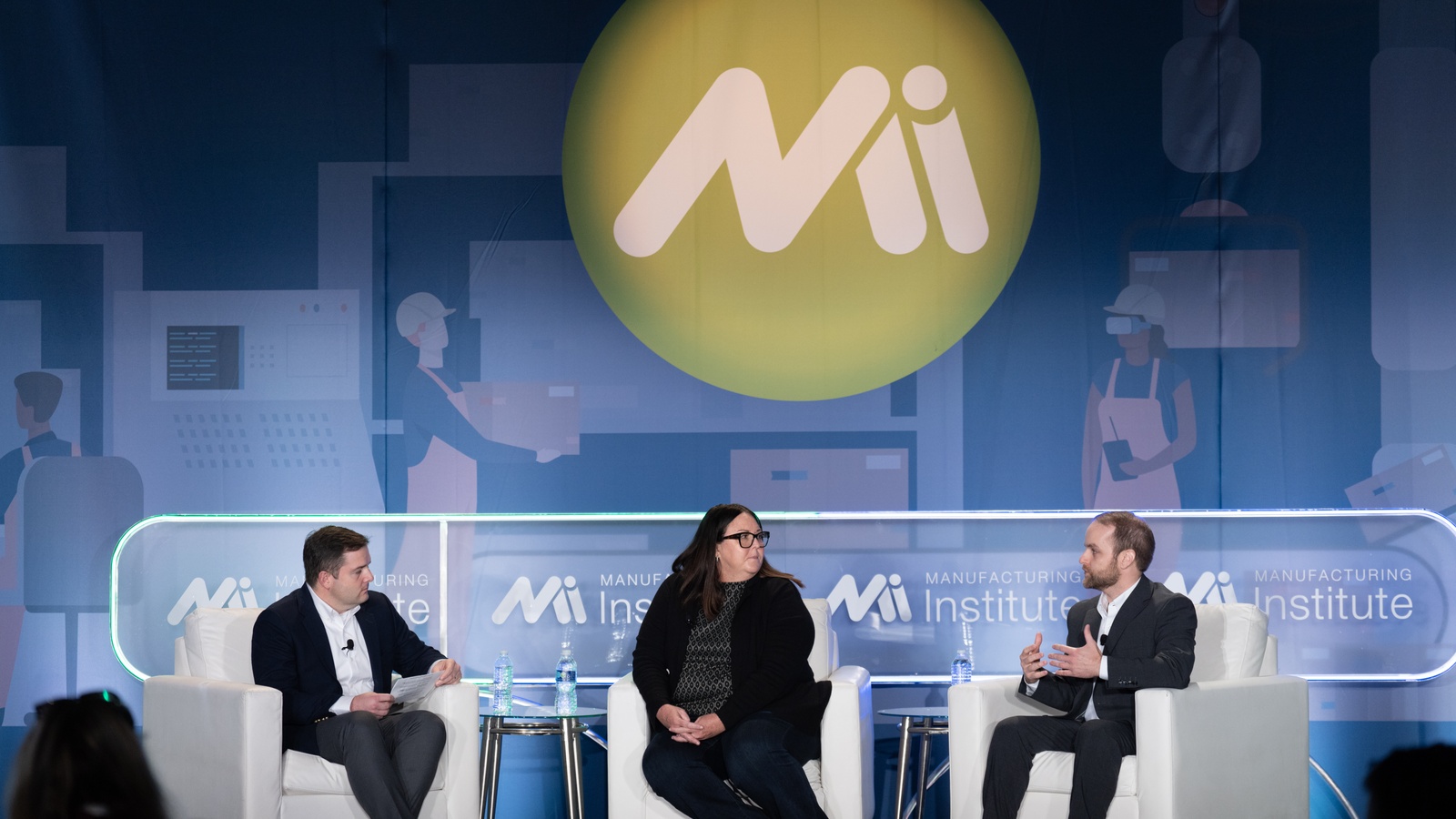
Many manufacturers pour their time and money into bolstering local programs for young people, hoping to shape the next generation of manufacturing workers. But how do they determine which organizations to work with, and how should those organizations attract their attention?
At the Manufacturing Institute’s inaugural Workforce Summit, held in Cincinnati back in October, panelists from WestRock Company and Arconic Foundation shared tips for those seeking to build partnerships with potential donors.
Top of mind: Education and workforce development, environment sustainability and social equity are all funding priorities, according to the panelists. Foundations and corporate donors are interested in programs that benefit local communities and reflect their organizations’ values.
- Mandy Burnette, director of corporate giving at WestRock, emphasized that the company looks for organizations that are capable of building a long-term relationship. As she put it, “We don’t give. We don’t donate. We invest in strategic partners.”
The perfect partner: Burnette and Arconic Foundation President and Treasurer Ryan Kish discussed what they look for when making funding decisions.
- A track record of success. Can the program be replicated successfully elsewhere? If so, that’s a huge plus, according to Kish. “A great example of this is FAME,” he added, referring to the workforce development program founded by Toyota and now operated by the MI. “You don’t need to convince me that FAME works. … If I have an opportunity to replicate FAME in one of our communities, I’m going to jump on that.”
- Impact: Kish said that he was drawn to the MI’s 35 x 30 campaign because he recognized that it was impactful. “It not only aligns with our funding priorities, but it’s going to affect a huge number of women and increase [the number of] women in the workplace. That’s what we’re after.”
Taking that first step: Both Burnette and Kish agreed that organizations should talk to their local connections, who will be able to steer them to the right decision-maker in a company or foundation.
- “If you’re reaching out, have a tight story,” Kish said. “Have your project activities, your budget, your timeline and impact story well-defined when you come to a local contact so that it grabs their attention and gets them engaged with you.”
Think long term: Beyond just focusing on attracting talent for jobs of today, foundations and companies are looking increasingly to support initiatives that build talent pipelines for the future.
- “All we’re doing right now [as an industry] is fighting over the same scarce talent,” Kish said. “Take the opportunity to make an investment in early STEM education to build the pipeline, so you’re not dealing with the same problem in 5 and 10 years.”
The last word: The best way to start thinking through partnerships? “Know your end result and then back into it. That’s what we did with our strategy. We knew what we were trying to accomplish and achieve, and then we backed into it and thought about the partners that could help us get to the results that we wanted,” Burnette said.
Manufacturers Should Hire Neurodiverse Workers—Here’s Why and How

Creators are always wanted in manufacturing, and those who bring new perspectives due to their neurological differences can be some of the most valuable.
That was one key takeaway from the Diversity + Inclusion Summit held this month by the Manufacturing Institute (the NAM’s workforce development and education partner). Dr. Keivan Stassun, director of the Frist Center for Autism and Innovation at Vanderbilt University, discussed the benefits of hiring neurodiverse workers, sharing tips on optimizing the hiring process for these workers as well as setting them up for success. Here’s some of his advice.
Why it matters: As manufacturers look for more workers to fill their hundreds of thousands of open positions, they are considering people of many different backgrounds and talents.
- Neurodiverse workers, who may include those with autism, Down syndrome, ADHD or other neurological conditions, have a wide range of abilities and perspectives and can enrich manufacturers’ operations.
- Stassun spoke from personal experience: at the Frist Center research lab, autistic individuals working with the proper support created a data visualization software that has been licensed by NASA, and also patented a technology for mining asteroids.
The benefits: “There are two broad categories of strengths that neurodiverse talent brings to the table—visual cognitive abilities and process/efficiency improvement,” said Stassun.
- Visual cognitive abilities can include skills such as pattern recognition and outlier detection, which can be useful in quality assurance tasks as varied as inspecting batteries coming off an assembly line, surveilling financial records for fraudulent or improper activity or stocking crash carts in emergency rooms.
- Process/efficiency improvement abilities emerge from neurodiverse workers’ atypical or novel perspectives, which help them identify out-of-the-box solutions. As Stassun explained, “Neurodiverse individuals can look at a process and abstract it into a flow chart to find ways to increase efficiencies that no one else would have even thought of.”
How to get started: Stassun recommends that companies try a small pilot program before rolling out a company-wide hiring initiative. He had a few key tips for the recruitment process:
- During the job interview stage, recruiters should be aware of ways in which neurodiversity can differ from neurotypical behavior. For example, interviewees may make minimal eye contact and use extremely direct verbal communication.
- To set neurodiverse workers up for success, companies should examine the sensory environment of their workplaces. Though workers’ needs will vary, they may be sensitive to light, temperature or noise and need certain accommodations, which should be arranged from the outset of employment.
Resources: Stassun offered two resources that will help companies find and retain neurodiverse talent:
- Mentra, a neurodiversity employment network that recruiters can search, and which allows neurodiverse individuals to share their backgrounds and strengths with employers.
- The Autism @ Work Playbook, which details how to create a supportive work environment for autistic individuals.
In addition, the MI provided other useful information in its recent D&I Roundtable on recruiting and retaining employees with neuro differences, which you can view here.
The last word: As Stassun noted, “Innovation often comes from the edges. From a human capital perspective, it’s a really exciting opportunity.”
